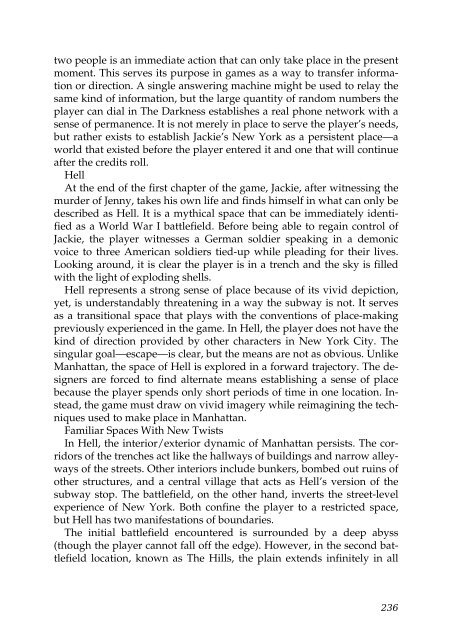Well Played 2.0: Video Games, Value and Meaning - OpenLibra
Well Played 2.0: Video Games, Value and Meaning - OpenLibra
Well Played 2.0: Video Games, Value and Meaning - OpenLibra
You also want an ePaper? Increase the reach of your titles
YUMPU automatically turns print PDFs into web optimized ePapers that Google loves.
two people is an immediate action that can only take place in the present<br />
moment. This serves its purpose in games as a way to transfer information<br />
or direction. A single answering machine might be used to relay the<br />
same kind of information, but the large quantity of r<strong>and</strong>om numbers the<br />
player can dial in The Darkness establishes a real phone network with a<br />
sense of permanence. It is not merely in place to serve the player’s needs,<br />
but rather exists to establish Jackie’s New York as a persistent place—a<br />
world that existed before the player entered it <strong>and</strong> one that will continue<br />
after the credits roll.<br />
Hell<br />
At the end of the first chapter of the game, Jackie, after witnessing the<br />
murder of Jenny, takes his own life <strong>and</strong> finds himself in what can only be<br />
described as Hell. It is a mythical space that can be immediately identified<br />
as a World War I battlefield. Before being able to regain control of<br />
Jackie, the player witnesses a German soldier speaking in a demonic<br />
voice to three American soldiers tied-up while pleading for their lives.<br />
Looking around, it is clear the player is in a trench <strong>and</strong> the sky is filled<br />
with the light of exploding shells.<br />
Hell represents a strong sense of place because of its vivid depiction,<br />
yet, is underst<strong>and</strong>ably threatening in a way the subway is not. It serves<br />
as a transitional space that plays with the conventions of place-making<br />
previously experienced in the game. In Hell, the player does not have the<br />
kind of direction provided by other characters in New York City. The<br />
singular goal—escape—is clear, but the means are not as obvious. Unlike<br />
Manhattan, the space of Hell is explored in a forward trajectory. The designers<br />
are forced to find alternate means establishing a sense of place<br />
because the player spends only short periods of time in one location. Instead,<br />
the game must draw on vivid imagery while reimagining the techniques<br />
used to make place in Manhattan.<br />
Familiar Spaces With New Twists<br />
In Hell, the interior/exterior dynamic of Manhattan persists. The corridors<br />
of the trenches act like the hallways of buildings <strong>and</strong> narrow alleyways<br />
of the streets. Other interiors include bunkers, bombed out ruins of<br />
other structures, <strong>and</strong> a central village that acts as Hell’s version of the<br />
subway stop. The battlefield, on the other h<strong>and</strong>, inverts the street-level<br />
experience of New York. Both confine the player to a restricted space,<br />
but Hell has two manifestations of boundaries.<br />
The initial battlefield encountered is surrounded by a deep abyss<br />
(though the player cannot fall off the edge). However, in the second battlefield<br />
location, known as The Hills, the plain extends infinitely in all<br />
236

















